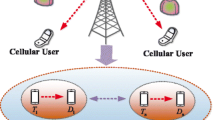Abstract
Device-to-device (D2D) communication is introduced in cellular networks to allow devices in close proximity to communicate directly with each other, freeing up spectral and other system resources. We propose a scheme that promotes the coexistence of cellular users (CUs) and D2D users (DUs). DUs are allowed to access the CU channel for D2D communications, enhancing the spectral efficiency. On the other hand, DU is expected to protect the secrecy of CU’s data by transmitting artificial noise to jam any potential eavesdroppers near the CU link, which may include other DUs. This enhances the cellular secrecy capacity at the expense of DU’s energy, which motivates us to assess the CU’s secrecy capacity and DU’s energy efficiency of this scheme. We have identified the causes and conditions of increased energy efficiency under certain secrecy capacity requirement, e.g. an optimal DU’s sensing duration that results in maximal energy efficiency. Such information is important for the planning of an efficient access control and scheduling scheme for the DU links in cellular networks.






Similar content being viewed by others
Availability of data and material
Not applicable.
Code availability
Not applicable.
References
Ali, A., Hamouda, W., & Uysal, M. (2015). Next generation M2M cellular networks: Challenges and practical considerations. IEEE Communications Magazine, 53(9), 18–24. https://doi.org/10.1109/MCOM.2015.7263368.
Poor, H. V., & Schaefer, R. F. (2017). Wireless physical layer security. Proceedings of the National Academy of Sciences U. S. A., 114(1), 19–26. https://doi.org/10.1073/pnas.1618130114.
Ma, C., Liu, J., Tian, X., Yu, H., Cui, Y., & Wang, X. (2015). Interference exploitation in D2D-enabled cellular networks: A secrecy perspective. IEEE Transactions on Communications, 63(1), 229–242. https://doi.org/10.1109/TCOMM.2014.2379633.
Wang, W., Teh, K. C., & Li, K. H. (2017). Enhanced physical layer security in D2D spectrum sharing networks. IEEE Wireless Communications Letters, 6(1), 106–109. https://doi.org/10.1109/LWC.2016.2634559.
Wang, L., Liu, J., Chen, M., Gui, G., & Sari, H. (2018). Optimization-based access assignment scheme for physical-layer security in D2D communications underlaying a cellular network. IEEE Transactions on Vehicular Technology, 67(7), 5766–5777. https://doi.org/10.1109/TVT.2017.2789022.
Wang, J., Huang, Y., Jin, S., Schober, R., You, X., & Zhao, C. (2018). Resource management for device-to-device communication: Aa physical layer security perspective. IEEE Journal on Selected Areas in Communications, 36(4), 946–960. https://doi.org/10.1109/JSAC.2018.2825484.
Zhang, H., Wang, T., Song, L., & Han, Z. (2014). Radio resource allocation for physical-layer security in D2D underlay communications. In 2014 IEEE international conference on communications, ICC 2014 (pp. 2319–2324). https://doi.org/10.1109/ICC.2014.6883669.
Zhang, R., Cheng, X., & Yang, L. (2016). Joint power and access control for physical layer security in D2D communications underlaying cellular networks. In 2016 IEEE international conference on communications, ICC 2016. https://doi.org/10.1109/ICC.2016.7511531.
Zhang, R., Cheng, X., & Yang, L. (2016). Cooperation via spectrum sharing for physical layer security in device-to-device communications underlaying cellular networks. IEEE Transactions on Wireless Communication, 15(8), 5651–5663. https://doi.org/10.1109/TWC.2016.2565579.
Zhang, Y., Shen, Y., Jiang, X., & Kasahara, S. (2019). Mode selection and spectrum partition for D2D inband communications: A physical layer security perspective. IEEE Transactions on Communications, 67(1), 623–638. https://doi.org/10.1109/TCOMM.2018.2865930.
Zhu, D., Swindlehurst, A. L., Fakoorian, S. A. A., Xu, W., & Zhao, C. (2014). Device-to-device communications: The physical layer security advantage. In ICASSP, IEEE international conference on acoustics, speech and signal processing—proceedings (pp. 1606–1610). https://doi.org/10.1109/ICASSP.2014.6853869.
Luo, Y., Cui, L., Yang, Y., & Gao, B. (2015). Power control and channel access for physical-layer security of D2D underlay communication. In 2015 International conference on wireless communications and signal processing, WCSP 2015. https://doi.org/10.1109/WCSP.2015.7341249.
Negi, R., & Goel, S. (2005). Secret communication using artificial noise. IEEE Vehicular Technology Conference, 3, 1906–1910. https://doi.org/10.1109/VETECF.2005.1558439.
Costa, M., & Ephremides, A. (2016). Energy efficiency versus performance in cognitive wireless networks. IEEE Journal on Selected Areas in Communications, 34(5), 1336–1347. https://doi.org/10.1109/JSAC.2016.2520219.
Nguyen, N. P., Thanh, T. L., Duong, T. Q., & Nallanathan, A. (2017). Secure communications in cognitive underlay networks over Nakagami-m channel. Physical Communiation, 25, 610–618. https://doi.org/10.1016/j.phycom.2016.05.003.
Liang, Y. C., Zeng, Y., Peh, E. C. Y., & Hoang, A. T. (2008). Sensing-throughput tradeoff for cognitive radio networks. IEEE Transactions on Wireless Communications, 7(4), 1326–1337. https://doi.org/10.1109/TWC.2008.060869.
Althunibat, S., & Granelli, F. (2016). On results’ reporting of cooperative spectrum sensing in cognitive radio networks. Telecommunication Systems, 62(3), 569–580. https://doi.org/10.1007/s11235-015-0095-5.
Pei, Y., Liang, Y. C., Teh, K. C., & Li, K. H. (2011). Energy-efficient design of sequential channel sensing in cognitive radio networks: Optimal sensing strategy, power allocation, and sensing order. IEEE Journal on Selected Areas in Communications, 29(8), 1648–1659. https://doi.org/10.1109/JSAC.2011.110914.
Funding
Not applicable.
Author information
Authors and Affiliations
Corresponding author
Ethics declarations
Conflict of interest
On behalf of all authors, the corresponding author states that there is no conflict of interest.
Additional information
Publisher's note
Springer Nature remains neutral with regard to jurisdictional claims in published maps and institutional affiliations.
Rights and permissions
About this article
Cite this article
Foo, YL. Secrecy capacity and energy efficiency in D2D-enabled cellular networks. Telecommun Syst 77, 351–357 (2021). https://doi.org/10.1007/s11235-021-00757-2
Accepted:
Published:
Issue Date:
DOI: https://doi.org/10.1007/s11235-021-00757-2




